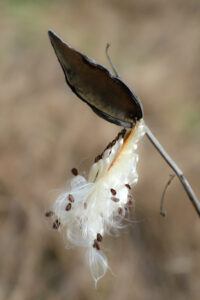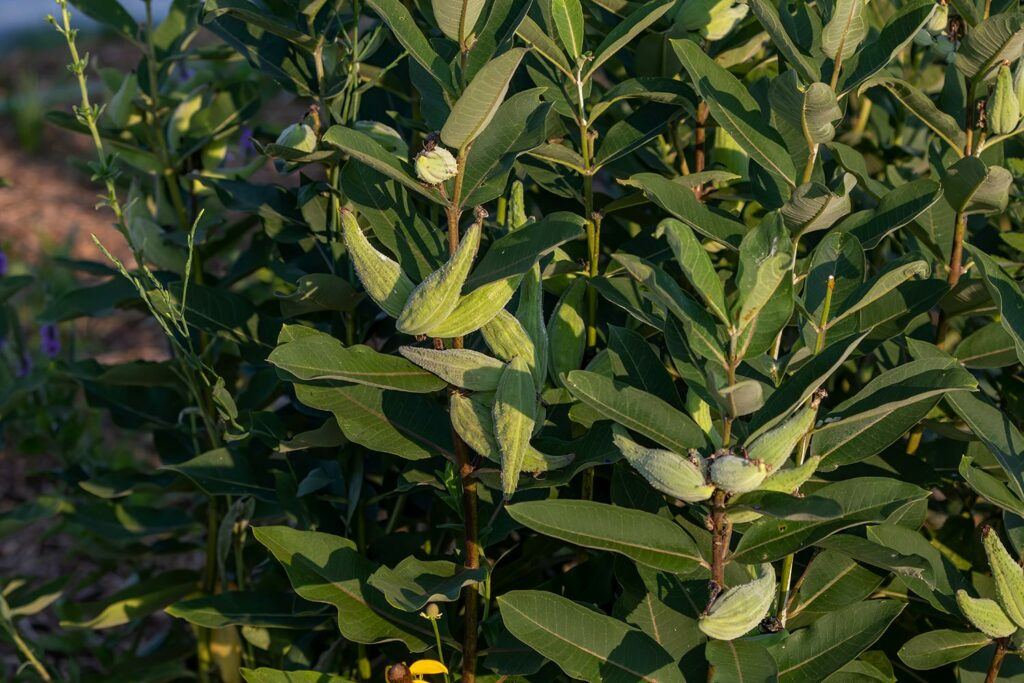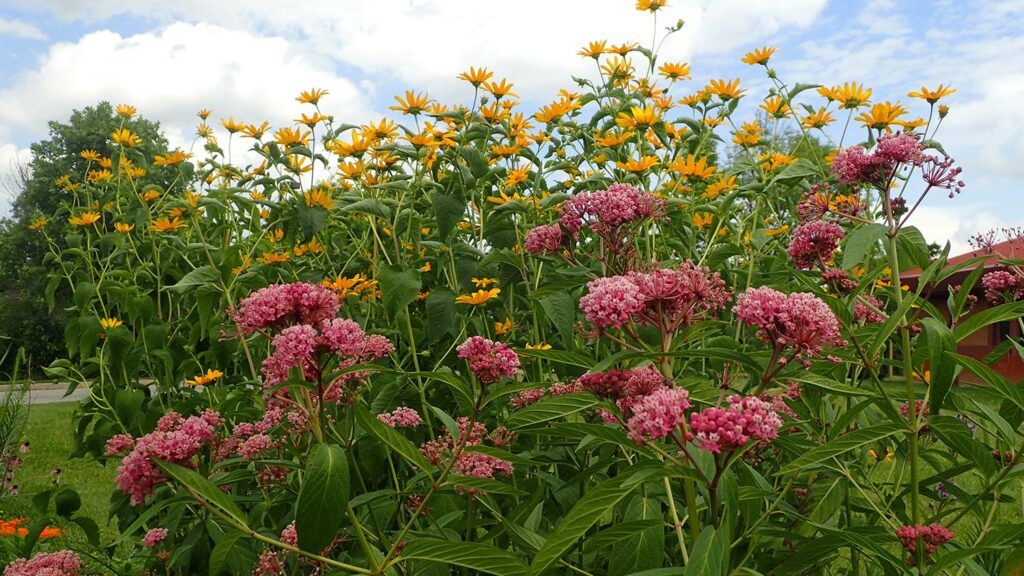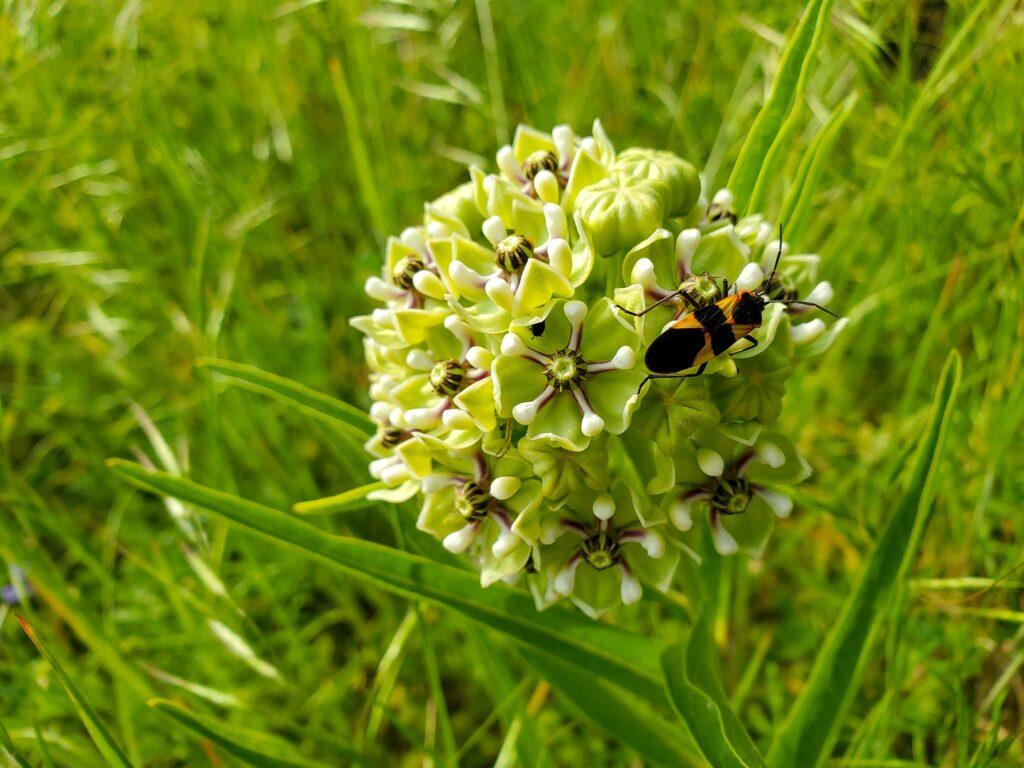
By Angelo Randaci, Earth’s Ally Horticulturist
Angelo’s passion for plants has led him to explore many areas of horticulture including research, grounds management, technical training, design and nursery management.
Milkweeds have served both humans and animals throughout our history in many remarkable ways. Native Americans used milkweed plants as a food and medicine once properly prepared. They also made twine and rope from the course, stringy stems. Even the white, silky fluff attached to the seeds had practical uses. The fluff has great insulating properties and was used by Americans to stuff mattresses and pillows as well as to line clothing, blankets, and footwear.

Milkweeds Attract Pollinators in Great Numbers
There are more than 100 different species of native milkweeds found in North and Central America which serve as shelter, nesting habitat, and as a food source for numerous animal species. Over 450 species of insects rely on milkweed plants as a food source, including different species of butterflies and bees. Bees and butterflies, including the monarch butterfly, flock to the nectar of milkweed blooms. All milkweed species serve as critical hosts for monarch butterflies. Milkweed is an exclusive food for monarch caterpillars and a host plant for the tussock moth and ladybugs. You will often see different species of butterflies and bees feeding on milkweed plants at the same time.
Besides attracting multitudes of pollinators, milkweeds will unify diverse gardens with beautiful native plants. There are milkweed species that are native to most regions of the USA. They are classic American wildflowers that deserve a place in all American gardens.
What Does Milkweed Look Like?
Milkweeds are wonderful additions to the garden. Because they can be found in almost any habitat whether dry, wet, or standard garden soil, the milkweed group offers a vibrant spectrum of different colors and forms to fit most any garden situation wherever you live. The showy clusters of flowers are a magnet for butterflies and pollinators.
Three main species of native milkweeds, found throughout most of the US are mentioned here: Common Milkweed, Swamp Milkweed, and Butterfly Weeds. Each of them has attractive pod-like fruits and display white fluffy hairs (also called floss, pappus, coma or silk) attached to each seed to facilitate their wind dispersal. They will thrive in a wide range of garden and meadow habitats from the eastern seaboard to the Rocky Mountains, including parts of Canada.

Common Milkweed (Asclepias syriaca) – USDA hardiness zones 3-10b
Common milkweed is a widespread species found throughout most of the eastern United States as well as southern Canada from New Brunswick to Saskatchewan. It grows to 5 feet tall and doesn’t need staking. Although frequently found growing along fence rows, roadsides, in fields, prairies and pastures, it shines in the garden with its impressive flowering show. Sweetly scented flowers from June to August are borne in 2-5 umbels clustered at the top of the plant. Flowers range in colors from greenish pink to rosy pink, to purplish pink. The pods are another ornamental feature. The green pods are about 4 inches long, turning brown at maturity.

These perennials spread through rhizomes and often appear to travel through the garden. These are easily controlled although allowing them to move through the garden will help create a pollinator heaven.

Swamp Milkweed (Asclepias incarnata) – USDA zones 3-10b. Swamp milkweed is also found growing throughout most of the US but the only one that grows in moist, wetland areas in full sun. Delicately scented flowers appear on 3–5-foot plants in shades of light pink, reddish violet or occasionally white. Besides planting along edges of ponds and streams, swamp milkweed is ideal for sunny borders, cottage gardens, wet meadows, and rain gardens. Three popular varieties of swamp milkweed include ‘Ice Ballet’ a white flowered form as well as two pink selections, ‘Soulmate’ and ‘Cinderella’.

Butterfly weed (Asclepias tuberosa) – USDA zones 3-9. Butterfly weed, unlike swamp milkweed, is commonly found in dry open habitats and is common in prairies and grasslands of the Midwest and Great Plains. It is found growing in gardens from Maine to South Dakota and southwest to Florida. Unlike other species of milkweed butterfly weed does not contain the characteristic thick milky sap but has a watery translucent sap instead. This hardy perennial is often planted in garden borders for its reliable bright orange or yellow flowers for up to two months during the summer. Growing only to 2 feet, it makes a wonderful plant for the front or middle of the border. The erect seedpods create a unique display in autumn.

How to Grow Milkweed in Your Home Garden
Growing: You can either purchase plants or start them from seeds. Purchasing plants will give you a flowering plant much sooner but if a quantity of plants is needed, sowing seeds is the way to go. Seeds require a cold period to break dormancy. Remove seeds from the fluff, place in a damp paper towel and into a plastic bag. Label and date the baggie and place in the refrigerator for 30 days. Remove and sow in containers of your choice until large enough to plant into the garden.
Research which milkweeds are native to your area. Native plant nurseries are the best sources of information. Visit your local native plant nursery if you have one nearby, or purchase plants for your area through the mail. Depending on your hardiness zone, planting non-native milkweed can disrupt the migration patterns of pollinators. When this happens, it can negatively impact pollination in different regions, having the opposite intended effect.
Purchasing rooted plants will give you a blooming plant much sooner than if you start milkweeds from seeds. Seedlings will not bloom until the third season of growth. Also, many species of milkweed seeds need to go through a cold period before they will germinate.
Planting: Young plants have delicate root systems that do not like to be disturbed. Plant carefully at the same depth that your plant came in the pot in a well-draining soil. Keep your plants watered until they become established but do not keep the soil saturated. Avoid competition from other plants while your milkweed is in early stages of growth.
Managing your plants: Most milkweed species form colonies by spreading via rhizomes and seeds.If growing in a meadow or wildflower situation, they will spread naturally, but care must be taken if growing in a small garden area. This is especially true if planting common milkweed. You can keep it from spreading by removing the seed pods before they open and disperse their seeds. To manage the rhizomatous habit, plant in a raised bed or in a container sunken in the ground.
Staking: Milkweeds grow on sturdy stems, so no staking is necessary.
Watering: While swamp milkweed varieties require a moist environment or regular watering, common milkweeds and butterfly weeds prefer a dry environment and will not need water once established.
Fertilizing: Milkweeds perform well poor soils and do not require fertilization.
Mulching: You may mulch milkweeds for weed control but avoid adding too much mulch to milkweeds that prefer dry soil.
Trimming & Pruning: You do not need to prune or trim your plants.
Dividing & Transplanting: Not recommended. All Milkweed, and swamp milkweed in particular, develop a deep tap-root, and do not like to be disturbed once established.
Milkweed Pests & Diseases
While the sticky white sap exuded from milkweeds contain toxic chemicals to deter many insect pests, certain insects are immune to the toxins and will even thrive on milkweed plants. Depending on where you live, milkweeds attract a variety of unwanted pests such as aphids, spider mites, whiteflies, thrips, milkweed beetles and milkweed bugs.

Milkweed bugs, and milkweed beetles are usually not a problem unless they reach large numbers on your plants. The easiest way to control them is to prepare a container of soapy water and either tap the plants over the soapy container to remove bugs or put on gloves and run your hand along the stems to remove the bugs over your container of soapy water.

Be sure to identify the pest before taking any action. You can collect pest samples or take pictures of them to your local extension office for identification. Choose Bee Safe® pesticides; avoid synthetic pesticides that cause harm to beneficial insects as well as monarchs, their caterpillars, and other pollinators. Follow label instructions and precautions. Aphids, whiteflies, spider mites, and thrips are easily controlled by Earth’s Ally 3- in-1 or Earth’s Ally Insect Control safely and effectively.
Toxicity: is Milkweed Poisonous?
Toxicity: The milky sap contains toxins which are toxic to animals and humans if consumed in large quantities. Animals and people usually avoid them because of the extremely bitter taste. Wash hands and wear gardening gloves if handling because the milky sap may irritate eyes and skin.
We’d love to hear how Earth’s Ally is helping you grow healthy pollinator gardens. Share your experience with our bee safe formulas and stay connected with the #EarthsAlly community on Facebook, Instagram and Twitter for access to our latest blog posts, giveaways and exclusive promotions.
